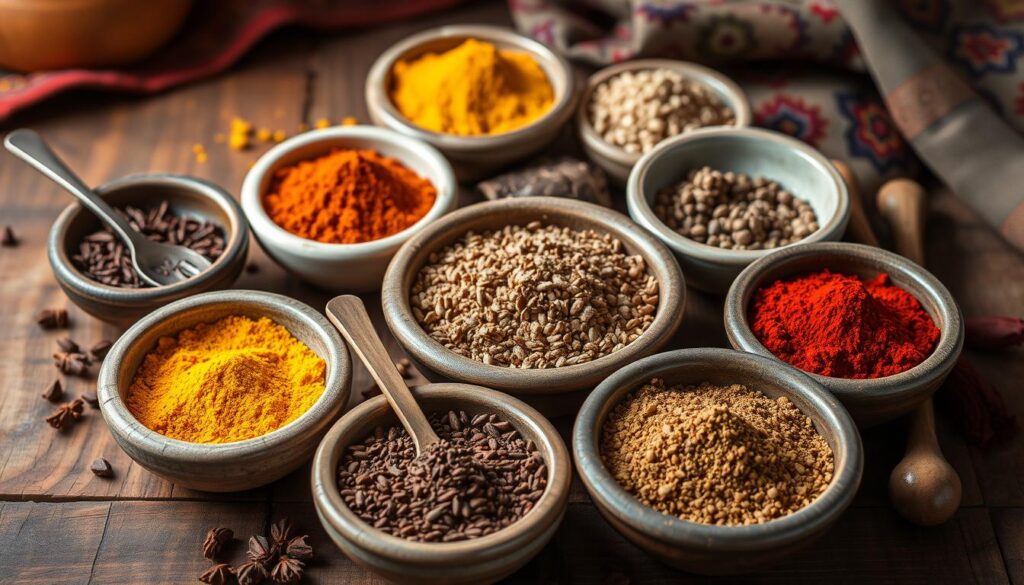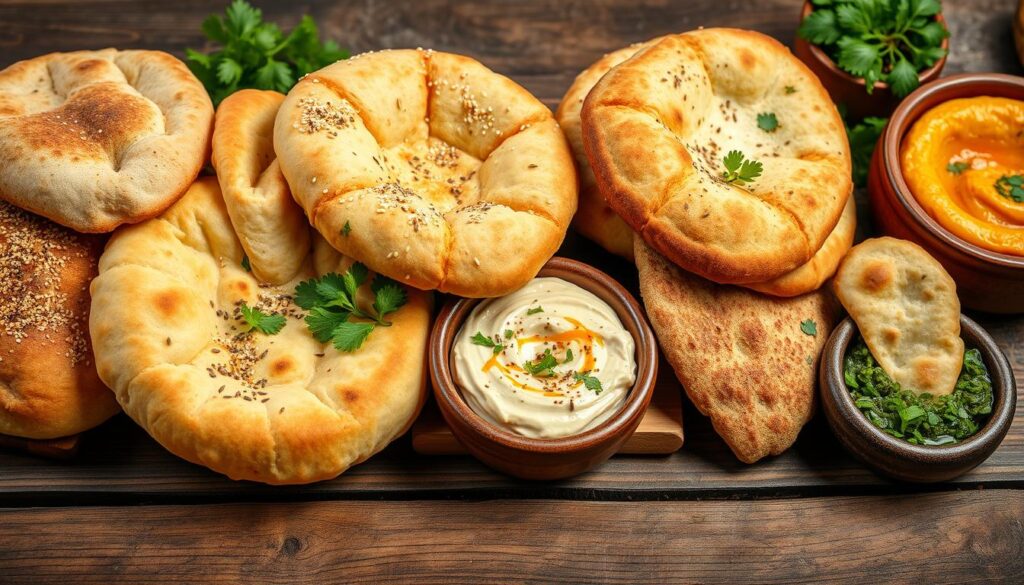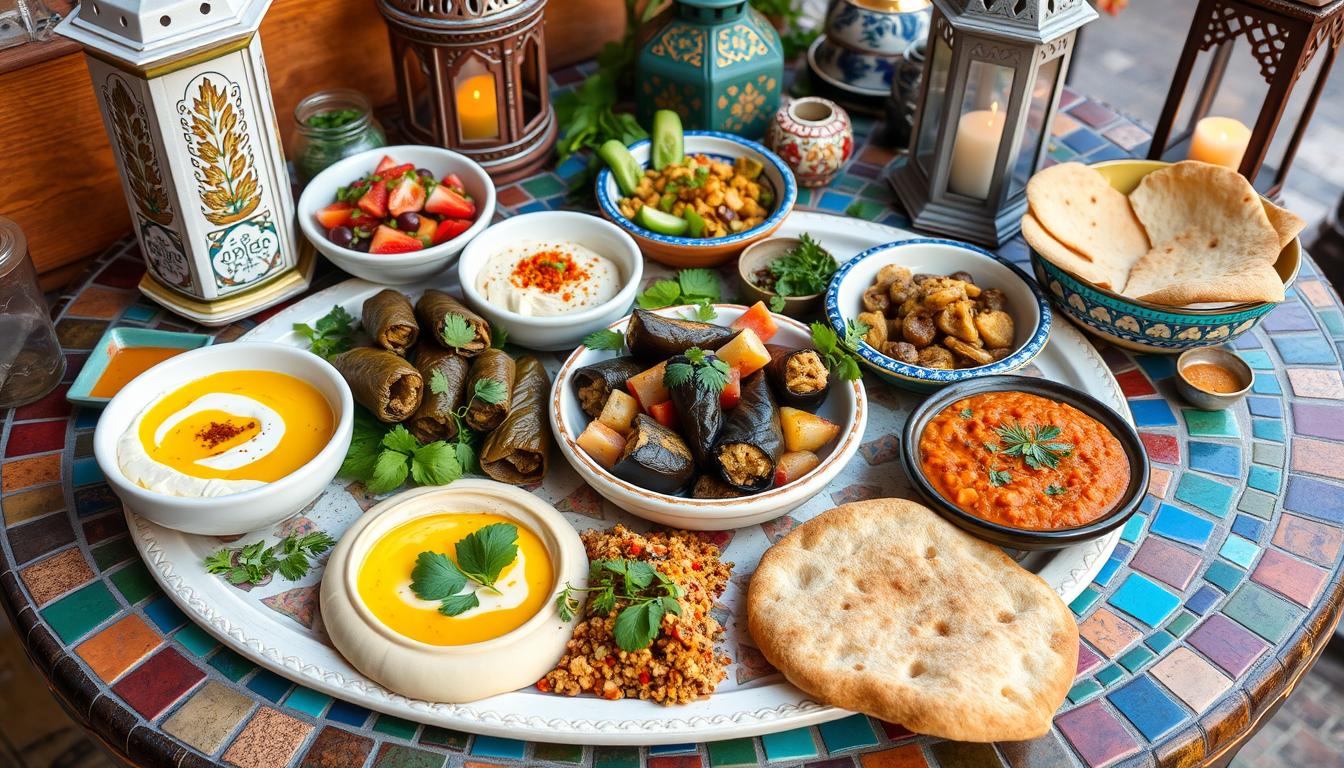The scent of toasted spices and simmering lentils fills the air, taking me to the bustling markets of the Middle East. As a passionate home cook, I’ve always been drawn to the vibrant flavors and nourishing ingredients of this ancient tradition. Let’s explore 25 easy Middle Eastern dishes that celebrate the region’s rich heritage and versatile vegetarian options.
These recipes range from creamy homemade hummus to fragrant tabbouleh. You’ll learn to make authentic falafel and enjoy roasting eggplant for baba ganoush. Each dish shows how the Middle East turns simple ingredients into culinary wonders.
Whether you’re a seasoned Middle Eastern food lover or new to these flavors, this collection will take your taste buds on a journey. Get ready to be amazed by the symphony of spices, vibrant colors, and nourishing goodness in these dishes.
Table of Contents
Key Takeaways
- Discover a diverse array of 25 easy Middle Eastern vegetarian recipes.
- Explore the rich flavors and nourishing ingredients that define this ancient culinary tradition.
- Learn to craft authentic dishes like hummus, falafel, and tabbouleh.
- Embrace the versatility of plant-based Middle Eastern cuisine, from hearty mains to fresh salads.
- Immerse yourself in the vibrant colors, aromatic spices, and cultural heritage of Middle Eastern vegetarian cooking.
Essential Middle Eastern Vegetarian Recipes You Need to Try
Explore the exciting world of Middle Eastern vegetarian food with these must-try recipes. You’ll love the creamy hummus, the crispy falafel, and the smoky baba ganoush. These dishes are the essence of Middle Eastern appetizers. Prepare to travel through the vibrant flavors of the Levant and beyond.
Classic Hummus and Variations
Hummus, the favorite chickpea spread, is a must-have in every home. Made with chickpeas, tahini, lemon juice, and garlic, it’s a real treat. Try adding roasted red peppers, sun-dried tomatoes, or lentils for a new twist.
Traditional Falafel Recipe
Falafel, the famous chickpea or broad bean balls, are a hit in Lebanon and Egypt. Get the perfect texture by following the traditional method. Enjoy them in a warm pita or on a colorful mezze platter.
Authentic Baba Ganoush
Baba ganoush, the eggplant spread, has a unique smoky taste and creamy texture. Roast the eggplant to get its true flavor. Serve it with fresh pita, crunchy veggies, or as a mezze dip.
“Exploring the vibrant flavors of Middle Eastern vegetarian cuisine is a culinary adventure that will transport your taste buds to a world of rich, aromatic delights.”
The Art of Middle Eastern Mezze Platters
Explore the rich flavors and textures of the Middle East with a mezze platter. Mezze is all about sharing small plates and dips, a tradition that brings people together. It’s a journey through the Middle East’s diverse tastes, from creamy hummus to smoky baba ganoush.
A mezze platter is filled with savory dips and spreads. You’ll find classics like hummus and baba ganoush. Add tangy tzatziki sauce, zesty tapenade, or vibrant muhammara for variety. These dips are great with warm pita bread or pita chips.
For texture and variety, add falafel and dolmades. Sprinkle the platter with crudités like cucumber sticks and cherry tomatoes. They add a refreshing touch.
No mezze platter is complete without tangy cheeses and dukkah. Top it off with figs, grapes, and a drizzle of olive oil. This makes for a feast that’s both captivating and sharable.
| Mezze Platter Components | Quantity |
|---|---|
| Hummus | 8 ounces |
| Tapenade | 8 ounces |
| Eggplant Dip | 8 ounces |
| Marinated Artichoke Hearts | 12 ounces |
| Marinated Feta | 8 ounces |
| Marinated Olives | 8 ounces |
| Stuffed Grape Leaves (Dolma) | 6 ounces |
| Pita Bread, cut into triangles | 4 pitas |
| Pita Chips | 18 ounces |
| Persian Cucumbers, cut into sticks | 1 pound |
| Carrots, halved or crinkle cut | 1 bunch |
| Cherry Tomatoes on the vine | 1 pound |
| Fresh Figs, cut into quarters | 4 figs |
| Dukkah | 1/2 cup |
| Bread Dipping Oil | As needed |
Creating a mezze platter is an art that celebrates Middle Eastern cuisine. It’s a way to share a variety of dips, spreads, and small dishes. This invites guests to enjoy a sensory journey through the mezze experience.
Vibrant Middle Eastern Salads and Fresh Dishes
Explore the vibrant world of Middle Eastern salads. Here, fresh ingredients and bold flavors come together. You’ll find classics like tabbouleh, fattoush, and Shirazi salad, all showing off the best of Middle Eastern cuisine.
Classic Tabbouleh
Tabbouleh is a favorite Middle Eastern salad. It’s made with parsley, tomatoes, bulgur wheat, and a zesty dressing. This salad is full of nutrients and shows the region’s love for fresh ingredients.
The parsley adds bright herbal notes, while the tomatoes bring juiciness. The bulgur wheat adds a chewy texture. Together, they make a balanced and satisfying salad that will excite your taste buds.
Fattoush with Pita Croutons
Fattoush is a crunchy salad from Lebanon, Syria, and Palestine. It’s a mix of crisp vegetables, herbs, and toasted or fried Arabic bread. The dressing is zesty, with lemon juice, olive oil, and spices.
The pita croutons add a fun texture. This makes fattoush a memorable dish that celebrates Middle Eastern flavors.
Shirazi Salad
The Shirazi salad comes from Iran’s city of Shiraz. It’s a national dish, often served as an appetizer or side. The salad has diced tomatoes, cucumbers, onions, and a tangy dressing.
The fresh vegetables and zesty dressing make it refreshing. It’s a great way to cleanse your palate and enjoy Middle Eastern cuisine.
These Middle Eastern salads are a feast for the senses. They celebrate the region’s culinary heritage. Whether you want a light side dish or a main course, these salads will delight you and leave you wanting more.
Hearty Lentil and Rice Dishes
Discover the comforting world of mujadara, a delicious Middle Eastern vegetarian dish. It mixes steamed rice and lentils with sweet caramelized onions. This recipe is perfect for a meatless meal, balancing proteins and carbs.
To make authentic mujadara, start by cooking sliced onions in olive oil until they’re golden brown. Then, add lentils and basmati rice, seasoned with spices like cumin, coriander, and cinnamon. Let it simmer until everything is tender and cooked just right.
Finish the dish with caramelized onions on top, fresh tomatoes, cucumber, and a dollop of yogurt. A sprinkle of sumac adds a tangy, lemony flavor. Enjoy this hearty dish as a main course or part of a Middle Eastern mezze.
| Ingredient | Quantity |
|---|---|
| Olive oil | 6 tablespoons |
| Onions, thinly sliced | 2 large |
| Basmati rice | 1 cup |
| Brown lentils | 1 cup |
| Ground cumin | 1/2 teaspoon |
| Ground coriander | 1 teaspoon |
| Ground allspice | 3/4 teaspoon |
| Ground cinnamon | 1 1/2 teaspoons |
| Sugar | 1 teaspoon |
| Kosher salt | 1 teaspoon |
| Tomatoes, diced | 1 cup |
| Cucumber, diced | 1 cup |
| Yogurt | 1/2 cup |
| Sumac | 1 teaspoon |
Mujadara is a classic Middle Eastern meatless main dish that pairs lentils and rice beautifully. This recipe shows the rich flavors and comforting textures of Middle Eastern vegetarian cooking.
Mujadara, once a “poor man’s dish,” is now a beloved staple. It’s a mix of tender lentils, fragrant rice, and sweet onions. It’s a nutritious meal for any time of the year. Enjoy it as a main course or part of a Middle Eastern vegetarian main dishes spread.
Middle Eastern Vegetarian Recipes for Main Courses
Explore the amazing flavors of Middle Eastern vegetarian dishes. Try the stuffed grape leaves, the vegetable tagine, and the cauliflower and rice makloubeh. These dishes show the variety and creativity of plant-based Middle Eastern cooking.
Stuffed Grape Leaves
Known as Yalanji, these grape leaves are filled with rice, veggies, and herbs. It’s a favorite cold appetizer in the Middle East. Enjoy it with hummus and pita bread for a tasty main course.
Vegetable Tagine
A tagine is a stew cooked in a clay pot. This version uses veggies and Middle Eastern spices. Serve it over couscous or with flatbread for a filling meal.
Cauliflower and Rice Makloubeh
Makloubeh means “flipped” in Arabic. It’s a Palestinian dish with rice, veggies, and sometimes meat. This vegetarian version has cauliflower, spices, and basmati rice. It’s a beautiful and tasty dish.
These vegetarian main dishes from the Middle East are a treat. You can enjoy the comfort of stuffed grape leaves, the aroma of vegetable tagine, or the beauty of makloubeh. They’re all delicious and healthy.
Essential Spices and Seasonings in Middle Eastern Cooking
Start a flavorful journey through Middle Eastern spices and seasonings. Learn about the warm, aromatic blends that make this cuisine so captivating.
The Middle Eastern spice trinity includes cinnamon, cloves, and allspice. These spices create a robust base for many dishes. Za’atar, a mix of herbs, sesame seeds, and sumac, is used everywhere in the region.
Sumac adds a tangy, lemony flavor to dishes. It’s often sprinkled on top for a unique touch. Cumin, coriander, and turmeric are also key, adding earthy, aromatic notes to Middle Eastern food.
| Spice | Flavor Profile | Common Uses |
|---|---|---|
| Cardamom | Warm, slightly sweet, and citrusy | Biryani dishes, rice, and desserts |
| Baharat | A complex blend of spices, including black pepper, cinnamon, cloves, and nutmeg | Meat dishes, stews, and rice |
| Dukkah | A nutty, earthy spice blend with cumin, coriander, and hazelnuts | Dipping oils, roasted vegetables, and meats |
| Shawarma Spices | A mix of nutmeg, cloves, cardamom, turmeric, allspice, and red pepper flakes | Marinating and seasoning meats |
| Biryani Spice | A blend with notes of curry, turmeric, and allspice | Rice dishes and stews |
Discover the rich world of Middle Eastern spices. Let these vibrant flavors take your cooking to new heights.

Traditional Dips and Spreads
Explore the rich flavors of the Middle East with traditional dips and spreads. Discover muhammara, a red pepper and walnut dip from Syria. Also, learn about tahini-based sauces, a key part of Middle Eastern cuisine.
Muhammara Recipe
Muhammara is a bold dip with a stunning color and taste. It’s made with roasted red peppers, walnuts, breadcrumbs, olive oil, lemon juice, and spices. This Syrian specialty is creamy, slightly sweet, and great with pita bread or grilled meats.
To make it, roast red peppers at 400°F for 30-35 minutes. Then, blend them with the other ingredients until smooth. Serve it fresh or store it in the fridge for up to 2 weeks. You can also freeze it for up to 3 months.
Tahini-Based Sauces
Tahini, a sesame seed paste, is essential in Middle Eastern cooking. It’s the base for many tasty sauces and dressings. Drizzle tahini sauce over hummus, falafel, or salads for a creamy flavor.
To make tahini sauce, mix tahini, lemon juice, garlic, water, salt, and pepper. You can adjust it by adding herbs or spices. Try different flavors to find your favorite.
Explore the world of Middle Eastern dips. From muhammara to tahini sauces, these spreads will make your vegetarian meals amazing.
Middle Eastern Bread and Accompaniments
Explore the world of Middle Eastern bread and sides. At its core is the pita bread, a favorite in Arabic cuisine. It’s similar to naan and comes from the Middle East and Mediterranean. Making it at home is simple with flour, water, olive oil, salt, sugar, and yeast.
Manakeesh is another Middle Eastern flatbread loved by many. It’s topped with za’atar, cheese, or meat. This bread is great for sharing at big gatherings, making it a key part of Middle Eastern meals.
- Pita bread: A classic Arabic flatbread that’s perfect for dipping in hummus or stuffing with your favorite fillings.
- Manakeesh: A flavorful flatbread that can be topped with za’atar, cheese, or meat, ideal for sharing with family and friends.
Discovering Middle Eastern bread and sides is a treat for your senses. Whether you make pita at home or enjoy manakeesh, these breads and sides will become kitchen favorites.

“Bread is the staff of life, and a good pita bread is the centerpiece of any Middle Eastern meal.”
Vegetarian Soups and Stews
Discover the comforting flavors of Middle Eastern vegetarian soups and stews. Shorbet Adas, a vegan lentil soup, is a beloved staple during cold nights and the holy month of Ramadan. It’s packed with protein-rich lentils and aromatic spices. This hearty soup is often topped with crispy pita bread for added texture.
The spinach stew inspired by the Palestinian “Sabanekh bil hummus” is a heartier option. It combines fresh spinach, tender chickpeas, and fragrant Middle Eastern spices. This nourishing dish pairs perfectly with rice or warm pita bread, making it a satisfying meat-free meal.
Whether you’re craving a comforting lentil soup or a protein-packed vegetable stew, these Middle Eastern soups and stews are sure to become new favorites in your kitchen. Explore the rich culinary traditions of the region and savor the wholesome, plant-based goodness in every spoonful.
FAQ
What are some essential Middle Eastern vegetarian recipes to try?
You should try classic hummus, traditional falafel, and authentic baba ganoush. These dishes highlight the rich flavors and healthy ingredients of Middle Eastern cuisine.
How can I create a delicious Middle Eastern mezze platter?
For a traditional mezze platter, include dips like hummus and baba ganoush. Add chickpea fritters and dukkah (Egyptian nuts and spice blend). Serve with pita bread, roasted veggies, and fresh herbs for a fun spread.
What are some vibrant Middle Eastern salad options?
Try classic tabbouleh, fattoush, and Shirazi salad. These salads mix fresh parsley, tomatoes, bulgur wheat, and toasted pita. They offer a crunchy, refreshing taste of Middle Eastern flavors.
What are some hearty Middle Eastern lentil and rice dishes?
Mujadara is a comforting dish made with steamed rice, lentils, caramelized onions, cinnamon, and allspice. It’s often topped with fresh veggies and tangy yogurt.
What are some popular Middle Eastern vegetarian main course options?
Yalanji (stuffed grape leaves), vegetable tagine, and makloubeh (a layered rice, vegetable, and sometimes meat dish) are great options. They show the variety and creativity of Middle Eastern vegetarian dishes.
What are some essential spices and seasonings used in Middle Eastern cooking?
Important spices include cinnamon, cloves, allspice, za’atar, sumac, cumin, coriander, and turmeric. These create rich, aromatic flavors in Middle Eastern dishes.
What are some traditional Middle Eastern dips and spreads to try?
Try muhammara, a Syrian red pepper and walnut dip, and tahini sauce, a versatile sesame seed condiment. These dips are great for vegetarian meals.
What are some popular Middle Eastern breads and accompaniments?
Pita bread and manakeesh, a flatbread topped with za’atar, cheese, or meat, are key. They’re often served with vegetarian dishes.
What are some comforting Middle Eastern vegetarian soups and stews?
Shorbet Adas, a vegan lentil soup, and vegetable stews with chickpeas, like the spinach stew inspired by Palestinian “Sabanekh bil hummus,” are perfect for cold nights or Ramadan.

